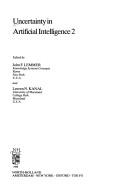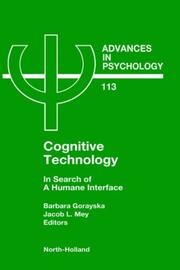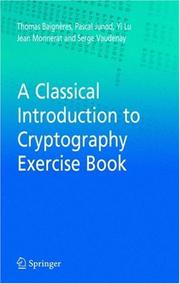| Listing 1 - 9 of 9 |
Sort by
|
Book
ISBN: 3540063633 3540366571 Year: 1973 Publisher: Berlin ; Heidelberg ; New York : Springer-Verlag,
Abstract | Keywords | Export | Availability | Bookmark
 Loading...
Loading...Choose an application
- Reference Manager
- EndNote
- RefWorks (Direct export to RefWorks)
These lecture notes are the contents of a two-term course given by me during the 1970-1971 academic year as Morgan Ward visiting professor at the California Institute of Technology. The students who took the course were mathematics seniors and graduate students. Therefore a thorough knowledge of algebra. (a. o. linear algebra, theory of finite fields, characters of abelian groups) and also probability theory were assumed. After introducing coding theory and linear codes these notes concern topics mostly from algebraic coding theory. The practical side of the subject, e. g. circuitry, is not included. Some topics which one would like to include 1n a course for students of mathematics such as bounds on the information rate of codes and many connections between combinatorial mathematics and coding theory could not be treated due to lack of time. For an extension of the course into a third term these two topics would have been chosen. Although the material for this course came from many sources there are three which contributed heavily and which were used as suggested reading material for the students. These are W. W. Peterson's Error-Correcting Codes «(15]), E. R. Berlekamp's Algebraic Coding Theory «(5]) and several of the AFCRL-reports by E. F. Assmus, H. F. Mattson and R. Turyn ([2], (3), [4] a. o. ). For several fruitful discussions I would like to thank R. J. McEliece.
Mathematical control systems --- 519.7 --- 681.3*E4 --- Mathematical cybernetics --- Coding and information theory: data compaction and compression; formal modelsof communication; nonsecret encoding schemes--See also {681.3*H11} --- Coding theory. --- 681.3*E4 Coding and information theory: data compaction and compression; formal modelsof communication; nonsecret encoding schemes--See also {681.3*H11} --- 519.7 Mathematical cybernetics

ISBN: 012620862X 9780126208627 9786611227319 1281227315 0080509258 9780080509259 9781281227317 6611227318 Year: 2006 Publisher: Amsterdam, [Netherlands] : Morgan Kaufmann,
Abstract | Keywords | Export | Availability | Bookmark
 Loading...
Loading...Choose an application
- Reference Manager
- EndNote
- RefWorks (Direct export to RefWorks)
Each edition of Introduction to Data Compression has widely been considered the best introduction and reference text on the art and science of data compression, and the third edition continues in this tradition. Data compression techniques and technology are ever-evolving with new applications in image, speech, text, audio, and video. The third edition includes all the cutting edge updates the reader will need during the work day and in class. Khalid Sayood provides an extensive introduction to the theory underlying today's compression techniques with detailed instruction for their app
Coding theory --- Data compression (Telecommunication) --- 681.3*E4 --- Compression of data (Telecommunication) --- Data compression (Computer science) --- Data transmission systems --- Digital electronics --- Information theory --- Machine theory --- Signal theory (Telecommunication) --- Computer programming --- 681.3*E4 Coding and information theory: data compaction and compression; formal modelsof communication; nonsecret encoding schemes--See also {681.3*H11} --- Coding and information theory: data compaction and compression; formal modelsof communication; nonsecret encoding schemes--See also {681.3*H11} --- Coding theory.
Book
ISBN: 012491540X 9780080956220 008095622X 9786612755392 1282755390 9780124915404 Year: 1975 Volume: 113 Publisher: New York : Academic Press,
Abstract | Keywords | Export | Availability | Bookmark
 Loading...
Loading...Choose an application
- Reference Manager
- EndNote
- RefWorks (Direct export to RefWorks)
In this book, we study theoretical and practical aspects of computing methods for mathematical modelling of nonlinear systems. A number of computing techniques are considered, such as methods of operator approximation with any given accuracy; operator interpolation techniques including a non-Lagrange interpolation; methods of system representation subject to constraints associated with concepts of causality, memory and stationarity; methods of system representation with an accuracy that is the best within a given class of models; methods of covariance matrix estimation;methods for low-rank
Mathematical logic --- System analysis. --- Systèmes, Théorie des. --- System theory. --- Systèmes d'aide à la décision --- Decision support systems --- System Analysis --- System theory --- Théorie des systèmes --- ELSEVIER-B EPUB-LIV-FT --- Network analysis --- Network science --- Network theory --- Systems analysis --- Mathematical optimization --- System analysis --- 519.71 --- 681.3*H11 --- 519.71 Control systems theory: mathematical aspects --- Control systems theory: mathematical aspects --- 681.3*H11 Systems and information theory: value of information--See also {681.3*E4} --- Systems and information theory: value of information--See also {681.3*E4} --- Decision support systems. --- Systèmes d'aide à la décision --- Systèmes, Théorie des --- Theorie du controle
Book
ISBN: 9780124915503 0124915507 9786613838360 0080955770 1283525917 Year: 1970 Volume: 68 Publisher: New York ; London : Academic Press,
Abstract | Keywords | Export | Availability | Bookmark
 Loading...
Loading...Choose an application
- Reference Manager
- EndNote
- RefWorks (Direct export to RefWorks)
In this book, we study theoretical and practical aspects of computing methods for mathematical modelling of nonlinear systems. A number of computing techniques are considered, such as methods of operator approximation with any given accuracy; operator interpolation techniques including a non-Lagrange interpolation; methods of system representation subject to constraints associated with concepts of causality, memory and stationarity; methods of system representation with an accuracy that is the best within a given class of models; methods of covariance matrix estimation;methods for low-rank
Systems Analysis --- System analysis --- Analyse de systèmes --- 681.3*H11 --- Systems and information theory: value of information--See also {681.3*E4} --- 681.3*H11 Systems and information theory: value of information--See also {681.3*E4} --- Analyse de systèmes --- EPUB-LIV-FT ELSEVIER-B --- System analysis. --- Systems Analysis. --- Large scale systems. --- Systèmes, Analyse de. --- Systèmes de grandes dimensions. --- Niet-lineaire systemen. --- Nonlinear systems -- Mathematical models. --- Optimaliseren. --- Civil & Environmental Engineering --- Mathematics --- Physical Sciences & Mathematics --- Engineering & Applied Sciences --- Operations Research --- Mathematical Theory --- Nichtlineare Optimierung --- Hierarchisches System --- Nonlinear systems --- Niet-lineaire systemen --- Optimaliseren --- Mathematical models --- Systems, Nonlinear --- System theory --- System --- Nichtlineare Programmierung --- Nichtlineares Optimieren --- Nichtlineares Programmieren --- Nonlinear programming --- Optimierung --- Mathematical models. --- Systèmes, Analyse de. --- Systèmes de grandes dimensions.

ISBN: 0444703969 1322472262 1483296539 9781483296531 9780444703965 Year: 1988 Volume: 5 Publisher: Amsterdam, Netherlands : New York, New York : North Holland, Elsevier Science Publishing Company, Inc.,
Abstract | Keywords | Export | Availability | Bookmark
 Loading...
Loading...Choose an application
- Reference Manager
- EndNote
- RefWorks (Direct export to RefWorks)
This second volume is arranged in four sections: Analysis contains papers which compare the attributes of various approaches to uncertainty. Tools provides sufficient information for the reader to implement uncertainty calculations. Papers in the Theory section explain various approaches to uncertainty. The Applications section describes the difficulties involved in, and the results produced by, incorporating uncertainty into actual systems.
681.3*E4 --- 681.3*I23 --- Coding and information theory: data compaction and compression; formal modelsof communication; nonsecret encoding schemes--See also {681.3*H11} --- Deduction and theorem proving: answer/reason extraction; reasoning; resolution; metatheory; mathematical induction; logic programming (Artificial intelligence) --- 681.3*I23 Deduction and theorem proving: answer/reason extraction; reasoning; resolution; metatheory; mathematical induction; logic programming (Artificial intelligence) --- 681.3*E4 Coding and information theory: data compaction and compression; formal modelsof communication; nonsecret encoding schemes--See also {681.3*H11} --- Artificial intelligence. --- Problem solving. --- Uncertainty (Information theory) --- Measure of uncertainty (Information theory) --- Shannon's measure of uncertainty --- System uncertainty --- Information measurement --- Probabilities --- Questions and answers --- Methodology --- Psychology --- Decision making --- Executive functions (Neuropsychology) --- AI (Artificial intelligence) --- Artificial thinking --- Electronic brains --- Intellectronics --- Intelligence, Artificial --- Intelligent machines --- Machine intelligence --- Thinking, Artificial --- Bionics --- Cognitive science --- Digital computer simulation --- Electronic data processing --- Logic machines --- Machine theory --- Self-organizing systems --- Simulation methods --- Fifth generation computers --- Neural computers --- Artificial intelligence --- Knowledge Representation --- Uncertainty
Book
ISBN: 0444850090 0444850104 9786612769788 0080954235 1282769782 9780444850102 9780444850096 Year: 1977 Volume: 16 Publisher: Amsterdam : North-Holland,
Abstract | Keywords | Export | Availability | Bookmark
 Loading...
Loading...Choose an application
- Reference Manager
- EndNote
- RefWorks (Direct export to RefWorks)
This book provides a comprehensive introduction to modern global variational theory on fibred spaces. It is based on differentiation and integration theory of differential forms on smooth manifolds, and on the concepts of global analysis and geometry such as jet prolongations of manifolds, mappings, and Lie groups. The book will be invaluable for researchers and PhD students in differential geometry, global analysis, differential equations on manifolds, and mathematical physics, and for the readers who wish to undertake further rigorous study in this broad interdisciplinary field.
Error-correcting codes (Information theory) --- Codes, Error-correcting (Information theory) --- Error-detecting codes (Information theory) --- Forbidden-combination check (Information theory) --- Self-checking codes (Information theory) --- Artificial intelligence --- Automatic control --- Coding theory --- Information theory --- 519.7 --- 681.3*E4 --- 519.7 Mathematical cybernetics --- Mathematical cybernetics --- 681.3*E4 Coding and information theory: data compaction and compression; formal modelsof communication; nonsecret encoding schemes--See also {681.3*H11} --- Coding and information theory: data compaction and compression; formal modelsof communication; nonsecret encoding schemes--See also {681.3*H11} --- Ergodic theory. Information theory --- Mathematical control systems --- Error-correcting codes (Information theory). --- Coding theory. --- Data compression (Telecommunication) --- Digital electronics --- Machine theory --- Signal theory (Telecommunication) --- Computer programming --- Codage --- Codes correcteurs d'erreurs (théorie de l'information)
Book
ISBN: 0471986054 9780471986058 Year: 1999 Publisher: Chichester Wiley
Abstract | Keywords | Export | Availability | Bookmark
 Loading...
Loading...Choose an application
- Reference Manager
- EndNote
- RefWorks (Direct export to RefWorks)
65.01 --- 681.3*H11 --- 681.3*H41 --- 681.3*K61 --- 681.3*K61 Project and people management: life cycle staffing systems analysis and design systems development training (Management of computing and information systems) --- Project and people management: life cycle staffing systems analysis and design systems development training (Management of computing and information systems) --- 681.3*H41 Office automation: equipment word processing--See also {681.3*I7} --- Office automation: equipment word processing--See also {681.3*I7} --- 681.3*H11 Systems and information theory: value of information--See also {681.3*E4} --- Systems and information theory: value of information--See also {681.3*E4} --- 65.01 Methods and methodology. Theory and practice of organization --- Methods and methodology. Theory and practice of organization --- System analysis --- System theory --- Systems, Theory of --- Systems science --- Science --- Network theory --- Systems analysis --- Mathematical optimization --- 681.3*K61 Project and people management: life cycle; staffing; systems analysis and design; systems development; training (Management of computing and information systems) --- Project and people management: life cycle; staffing; systems analysis and design; systems development; training (Management of computing and information systems) --- 681.3*H41 Office automation: equipment; word processing--See also {681.3*I7} --- Office automation: equipment; word processing--See also {681.3*I7} --- Philosophy --- Network analysis --- Network science --- Planning (firm) --- Computer architecture. Operating systems --- System analysis. --- System theory.

ISBN: 0444822755 9786611055332 1281055336 0080529313 9780444822758 9780080529318 Year: 1996 Publisher: Amsterdam ; New York : North Holland, Elsevier Science B.V.,
Abstract | Keywords | Export | Availability | Bookmark
 Loading...
Loading...Choose an application
- Reference Manager
- EndNote
- RefWorks (Direct export to RefWorks)
In this book the editors have gathered a number of contributions by persons who have been working on problems of Cognitive Technology (CT). The present collection initiates explorations of the human mind via the technologies the mind produces. These explorations take as their point of departure the question What happens when humans produce new technologies? Two interdependent perspectives from which such a production can be approached are adopted: How and why constructs that have their origins in human mental life are embodied in physical environments when people fabricate their hab
Artificial intelligence. --- Cognition --- Cognitive science --- Human information processing --- 130.2:6 --- 165.23 --- 681.3*H11 --- AI (Artificial intelligence) --- Artificial thinking --- Electronic brains --- Intellectronics --- Intelligence, Artificial --- Intelligent machines --- Machine intelligence --- Thinking, Artificial --- Bionics --- Digital computer simulation --- Electronic data processing --- Logic machines --- Machine theory --- Self-organizing systems --- Simulation methods --- Fifth generation computers --- Neural computers --- Information processing, Human --- Information theory in psychology --- Perception --- Science --- Philosophy of mind --- Psychology --- 165.23 Kennis: begripsanalyse naar woordbetekenis; betekeningsvraagstuk --- Kennis: begripsanalyse naar woordbetekenis; betekeningsvraagstuk --- 681.3*H11 Systems and information theory: value of information--See also {681.3*E4} --- Systems and information theory: value of information--See also {681.3*E4} --- 130.2:6 Filosofie van de cultuur. Cultuurfilosofie. Cultuursystemen. Kultuurfilosofie-:-Biomedische wetenschappen. Ingenieurswetenschappen. Computerwetenschap. Grafische industrie. Uitgeverij --- Filosofie van de cultuur. Cultuurfilosofie. Cultuursystemen. Kultuurfilosofie-:-Biomedische wetenschappen. Ingenieurswetenschappen. Computerwetenschap. Grafische industrie. Uitgeverij --- Artificial intelligence --- Philosophy and cognitive science. --- Technology --- Human-machine systems. --- Human information processing. --- Human operators (Systems engineering) --- Human subsystems (Systems engineering) --- Man-machine control systems --- Man-machine systems --- Operator-machine systems --- Engineering systems --- Human engineering --- Technology and civilization --- Cognitive science and philosophy --- Philosophy.

ISBN: 9780387279343 9780387288352 0387279342 038728835X 9786610969425 1280969423 Year: 2006 Publisher: New York : Springer,
Abstract | Keywords | Export | Availability | Bookmark
 Loading...
Loading...Choose an application
- Reference Manager
- EndNote
- RefWorks (Direct export to RefWorks)
This companion exercise and solution book to A Classical Introduction to Cryptography: Applications for Communications Security contains a carefully revised version of teaching material. It was used by the authors or given as examinations to undergraduate and graduate-level students of the Cryptography and Security Lecture at EPFL from 2000 to mid-2005. A Classical Introduction to Cryptography Exercise Book for A Classical Introduction to Cryptography: Applications for Communications Security covers a majority of the subjects that make up today's cryptology, such as symmetric or public-key cryptography, cryptographic protocols, design, cryptanalysis, and implementation of cryptosystems. Exercises do not require a large background in mathematics, since the most important notions are introduced and discussed in many of the exercises. The authors expect the readers to be comfortable with basic facts of discrete probability theory, discrete mathematics, calculus, algebra, as well as computer science. Following the model of A Classical Introduction to Cryptography: Applications for Communications Security, exercises related to the more advanced parts of the textbook are marked with a star.
Computer security --- Cryptography --- 681.3*E1 --- 681.3*E3 --- 681.3*E4 --- Cryptanalysis --- Cryptology --- Secret writing --- Steganography --- Signs and symbols --- Symbolism --- Writing --- Ciphers --- Data encryption (Computer science) --- Computer privacy --- Computer system security --- Computer systems --- Computers --- Cyber security --- Cybersecurity --- Electronic digital computers --- Protection of computer systems --- Security of computer systems --- Data protection --- Security systems --- Hacking --- 681.3*E3 Data encryption: data encryption standard; DES; public key cryptosystems --- Data encryption: data encryption standard; DES; public key cryptosystems --- 681.3*E1 Data structures: arrays; graphs; lists; tables; trees --- Data structures: arrays; graphs; lists; tables; trees --- 681.3*E4 Coding and information theory: data compaction and compression; formal modelsof communication; nonsecret encoding schemes--See also {681.3*H11} --- Coding and information theory: data compaction and compression; formal modelsof communication; nonsecret encoding schemes--See also {681.3*H11} --- Protection --- Security measures --- Computer security. --- Cryptography. --- Sécurité informatique --- Cryptographie --- Problems, exercises, etc. --- Problèmes et exercices --- EPUB-LIV-FT LIVINFOR SPRINGER-B --- Data encryption (Computer science). --- Information theory. --- Computer Communication Networks. --- Data structures (Computer science) --- Coding theory. --- Data transmission systems. --- Cryptology. --- Theory of Computation. --- Data Structures and Information Theory. --- Coding and Information Theory. --- Input/Output and Data Communications. --- Information structures (Computer science) --- Structures, Data (Computer science) --- Structures, Information (Computer science) --- Electronic data processing --- File organization (Computer science) --- Abstract data types (Computer science) --- Data communication systems --- Transmission of data --- Digital communications --- Electronic systems --- Information theory --- Telecommunication systems --- Data compression (Telecommunication) --- Digital electronics --- Machine theory --- Signal theory (Telecommunication) --- Computer programming --- Communication theory --- Communication --- Cybernetics --- Data encoding (Computer science) --- Encryption of data (Computer science) --- Computers. --- Computer communication systems. --- Data structures (Computer science). --- Input-output equipment (Computers). --- Computer hardware --- Computer I/O equipment --- Electronic analog computers --- Hardware, Computer --- I/O equipment (Computers) --- Input equipment (Computers) --- Input-output equipment (Computers) --- Output equipment (Computers) --- Communication systems, Computer --- Computer communication systems --- Data networks, Computer --- ECNs (Electronic communication networks) --- Electronic communication networks --- Networks, Computer --- Teleprocessing networks --- Data transmission systems --- Information networks --- Telecommunication --- Cyberinfrastructure --- Network computers --- Automatic computers --- Automatic data processors --- Computing machines (Computers) --- Electronic brains --- Electronic calculating-machines --- Electronic computers --- Calculators --- Cyberspace --- Input-output equipment --- Distributed processing
| Listing 1 - 9 of 9 |
Sort by
|

 Search
Search Feedback
Feedback About UniCat
About UniCat  Help
Help News
News